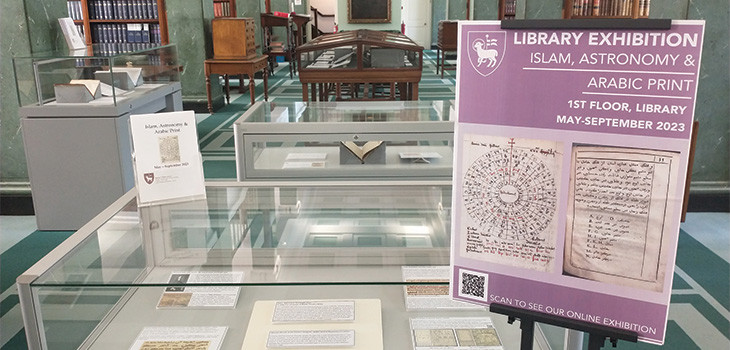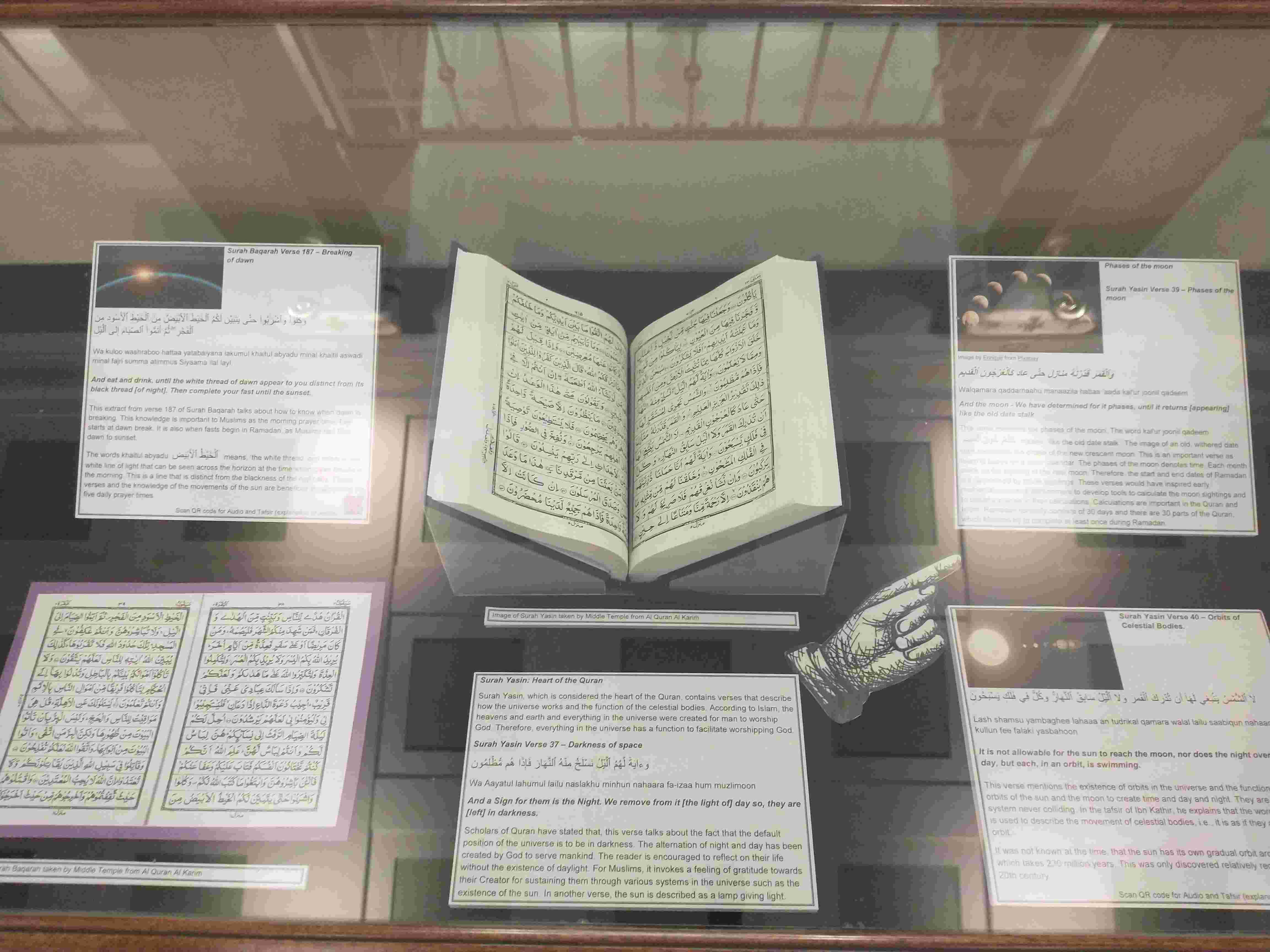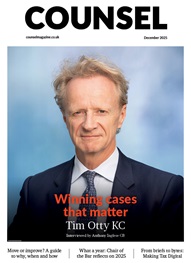*/

Curator Fariha Sikondari invites barristers to an exhibition taking a rare look at Islamic scholarship and how it shaped the world
I have been asked to write an article on the exhibition at Middle Temple Library, Islam, Astronomy & Arabic Print which I co-curated with Jake Hearn. This is something quite new and different for Middle Temple, which showcases items from Middle Temple’s special collections. These include early printed books containing Arabic script, Qurans from the Renaissance period, and Islamic astronomical manuscripts from the Middle Ages and Renaissance periods. The exhibition tells of an untold history of the impact of Islamic heritage in Europe.
To understand the context of the exhibits we need to look at what was going in Europe and around the world at that time. Islam had a significant influence in the world due to the succession of Islamic empires that existed from the 8th century through to the 19th century. Many new ideas and scientific and philosophical theories were filtering into Europe. This transmission of knowledge particularly took hold during the Renaissance, when various cities in Europe developed an Arabic press to disseminate the vast amount of knowledge being acquired from the Muslim world. European scholars and Orientalists would travel there to acquire precious manuscripts written in Arabic, Persian and other Eastern languages.
Members of the Inns of Court were involved in this incredible movement to transmit knowledge to the West, including John Selden and George Sale. John Selden wrote several books containing Arabic script. On display in a case, is an example of Arabic metal type, which shows the difficulty in capturing the shape of Arabic characters.
In the exhibition we take a look at a few Qurans translated into Italian, Latin and English. Qurans were translated into European languages from as early as the Middle Ages. The exhibition case also includes a contemporary English translation of the Quran, The Majestic Quran translated by Dr Musharraf Hussain, to give the audience a deeper understanding of the chapters. This copy is usually kept in the newly created multi-faith room on the 3rd floor of the library.
In another case, we have some verses from the Quran relating to astronomy, as they would have had an impact on the works of early Muslim scientists and thinkers. The verses encourage the reader to ponder their existence by looking at the movement of celestial bodies, and instruct them to investigate the universe to make firm their belief in God. As there is a link in Islam between belief in God and investigating the universe, combining the disciplines of theology, philosophy and science was part of the learning process of that time. I decided to include Quran verses in the exhibition as it gives the audience an opportunity to learn more about Islam. It also enables the audience to engage in the exhibition and contemplate the same verses that the early Muslim scholars would have contemplated. There are audio links and links to further explanation of verses.

Case showing Quran verses
Islamic scholarship began with the revelation of the Quran in the 7th century. From the 8th century onwards the Golden Age of Islam was propelled with the investment and patronage of Muslim rulers and wealthy individuals, and also led by the guiding Quranic principle to seek knowledge to find the truth of the Creator. Muslim rulers, such as Ulugh Beg and Shah Khulji were instrumental in providing the infrastructure to advance the fields of science and astronomy by building observatories and educational establishments, and by providing patronage to Royal Court employed astronomers. Centres of learning were established across the Muslim world from Islamic Spain to Timbuktu.
European scholars travelled to the Muslim world to learn the latest developments in the fields of medicine, science, mathematics, philosophy, theology, astronomy, amongst many other disciplines. They also travelled there to obtain valuable manuscripts. In the exhibition, we look at the astronomical manuscripts translated by the likes of John Greaves and Jacob Christmann. These were written centuries before by early Muslim astronomers who left their legacy by calculating the circumference of the earth, the distances of planets from the earth, developing instruments, astronomical tables, planetary models and introducing new mathematics, trigonometry and algebra to Europe.
---webd3f6ddf8-2779-4055-a09f-425013cd1b16.jpg?Status=Master&sfvrsn=5f5600f8_1)
Case containing Astronomica Quaedam ex Traditione Shah Cholgii Persae translated by John Greaves (1652)
Notably absent from our history books, are the many influential Muslim female scholars ranging from rulers and entrepreneurs to mathematicians, scientists, doctors and astronomers. Lubna of Cordoba, Spain, was a mathematician and intellectual in the 10th century, known for her abilities in grammar, science, geometry and algebra. She managed the library of Cordoba and wrote and translated manuscripts. Dahma bint Yahya lived in Yemen in the 15th century. She was a writer and teacher and excelled in science, astronomy and jurisprudence. In the exhibition, we mention Mariam al-Astrulabi who used her mathematical knowledge to refine the astrolabe, an instrument used to measure celestial bodies and the movement the sun. We also look at Fatima al-Fihri, a pioneering entrepreneur who founded the first degree-granting university in the world.
This is a unique exhibition which takes a rare look at Islamic scholarship and how it shaped the world, and inspired European scholars and scientists to master the Arabic language in order to benefit from the knowledge that was widely available in the Muslim world. It is also an exhibition which does not focus on the culture of Muslim lands but rather it is an opportunity for people to explore Islamic beliefs in more depth, which is not really experienced in other Islamic exhibitions. Hopefully, people will find it interesting and enjoy discovering new things from the legacy of Islamic heritage, and also appreciate the great accomplishments made by both Muslim and non-Muslim scholars to share and spread knowledge across the globe, which still benefit us today.

I have been asked to write an article on the exhibition at Middle Temple Library, Islam, Astronomy & Arabic Print which I co-curated with Jake Hearn. This is something quite new and different for Middle Temple, which showcases items from Middle Temple’s special collections. These include early printed books containing Arabic script, Qurans from the Renaissance period, and Islamic astronomical manuscripts from the Middle Ages and Renaissance periods. The exhibition tells of an untold history of the impact of Islamic heritage in Europe.
To understand the context of the exhibits we need to look at what was going in Europe and around the world at that time. Islam had a significant influence in the world due to the succession of Islamic empires that existed from the 8th century through to the 19th century. Many new ideas and scientific and philosophical theories were filtering into Europe. This transmission of knowledge particularly took hold during the Renaissance, when various cities in Europe developed an Arabic press to disseminate the vast amount of knowledge being acquired from the Muslim world. European scholars and Orientalists would travel there to acquire precious manuscripts written in Arabic, Persian and other Eastern languages.
Members of the Inns of Court were involved in this incredible movement to transmit knowledge to the West, including John Selden and George Sale. John Selden wrote several books containing Arabic script. On display in a case, is an example of Arabic metal type, which shows the difficulty in capturing the shape of Arabic characters.
In the exhibition we take a look at a few Qurans translated into Italian, Latin and English. Qurans were translated into European languages from as early as the Middle Ages. The exhibition case also includes a contemporary English translation of the Quran, The Majestic Quran translated by Dr Musharraf Hussain, to give the audience a deeper understanding of the chapters. This copy is usually kept in the newly created multi-faith room on the 3rd floor of the library.
In another case, we have some verses from the Quran relating to astronomy, as they would have had an impact on the works of early Muslim scientists and thinkers. The verses encourage the reader to ponder their existence by looking at the movement of celestial bodies, and instruct them to investigate the universe to make firm their belief in God. As there is a link in Islam between belief in God and investigating the universe, combining the disciplines of theology, philosophy and science was part of the learning process of that time. I decided to include Quran verses in the exhibition as it gives the audience an opportunity to learn more about Islam. It also enables the audience to engage in the exhibition and contemplate the same verses that the early Muslim scholars would have contemplated. There are audio links and links to further explanation of verses.

Case showing Quran verses
Islamic scholarship began with the revelation of the Quran in the 7th century. From the 8th century onwards the Golden Age of Islam was propelled with the investment and patronage of Muslim rulers and wealthy individuals, and also led by the guiding Quranic principle to seek knowledge to find the truth of the Creator. Muslim rulers, such as Ulugh Beg and Shah Khulji were instrumental in providing the infrastructure to advance the fields of science and astronomy by building observatories and educational establishments, and by providing patronage to Royal Court employed astronomers. Centres of learning were established across the Muslim world from Islamic Spain to Timbuktu.
European scholars travelled to the Muslim world to learn the latest developments in the fields of medicine, science, mathematics, philosophy, theology, astronomy, amongst many other disciplines. They also travelled there to obtain valuable manuscripts. In the exhibition, we look at the astronomical manuscripts translated by the likes of John Greaves and Jacob Christmann. These were written centuries before by early Muslim astronomers who left their legacy by calculating the circumference of the earth, the distances of planets from the earth, developing instruments, astronomical tables, planetary models and introducing new mathematics, trigonometry and algebra to Europe.
---webd3f6ddf8-2779-4055-a09f-425013cd1b16.jpg?Status=Master&sfvrsn=5f5600f8_1)
Case containing Astronomica Quaedam ex Traditione Shah Cholgii Persae translated by John Greaves (1652)
Notably absent from our history books, are the many influential Muslim female scholars ranging from rulers and entrepreneurs to mathematicians, scientists, doctors and astronomers. Lubna of Cordoba, Spain, was a mathematician and intellectual in the 10th century, known for her abilities in grammar, science, geometry and algebra. She managed the library of Cordoba and wrote and translated manuscripts. Dahma bint Yahya lived in Yemen in the 15th century. She was a writer and teacher and excelled in science, astronomy and jurisprudence. In the exhibition, we mention Mariam al-Astrulabi who used her mathematical knowledge to refine the astrolabe, an instrument used to measure celestial bodies and the movement the sun. We also look at Fatima al-Fihri, a pioneering entrepreneur who founded the first degree-granting university in the world.
This is a unique exhibition which takes a rare look at Islamic scholarship and how it shaped the world, and inspired European scholars and scientists to master the Arabic language in order to benefit from the knowledge that was widely available in the Muslim world. It is also an exhibition which does not focus on the culture of Muslim lands but rather it is an opportunity for people to explore Islamic beliefs in more depth, which is not really experienced in other Islamic exhibitions. Hopefully, people will find it interesting and enjoy discovering new things from the legacy of Islamic heritage, and also appreciate the great accomplishments made by both Muslim and non-Muslim scholars to share and spread knowledge across the globe, which still benefit us today.
Curator Fariha Sikondari invites barristers to an exhibition taking a rare look at Islamic scholarship and how it shaped the world


Chair of the Bar reflects on 2025
Q&A with criminal barrister Nick Murphy, who moved to New Park Court Chambers on the North Eastern Circuit in search of a better work-life balance
Revolt Cycling in Holborn, London’s first sustainable fitness studio, invites barristers to join the revolution – turning pedal power into clean energy
Rachel Davenport, Co-founder and Director at AlphaBiolabs, reflects on how the company’s Giving Back ethos continues to make a difference to communities across the UK
By Marie Law, Director of Toxicology at AlphaBiolabs
AlphaBiolabs has made a £500 donation to Sean’s Place, a men’s mental health charity based in Sefton, as part of its ongoing Giving Back initiative
Professor Dominic Regan and Seán Jones KC present their best buys for this holiday season
Little has changed since Burns v Burns . Cohabiting couples deserve better than to be left on the blasted heath with the existing witch’s brew for another four decades, argues Christopher Stirling
Six months of court observation at the Old Bailey: APPEAL’s Dr Nisha Waller and Tehreem Sultan report their findings on prosecution practices under joint enterprise
Despite its prevalence, autism spectrum disorder remains poorly understood in the criminal justice system. Does Alex Henry’s joint enterprise conviction expose the need to audit prisons? asks Dr Felicity Gerry KC
With automation now deeply embedded in the Department for Work Pensions, Alexander McColl and Alexa Thompson review what we know, what we don’t and avenues for legal challenge